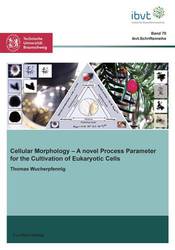| Areas | |
|---|---|
| Serie de libros (96) |
1378
|
| Nachhaltigkeit |
3
|
| Gesundheitswesen |
1
|
| Letra |
2364
|
| Ciencias Naturales |
5406
|
| Matemática | 229 |
| Informática | 319 |
| Física | 980 |
| Química | 1363 |
| Geociencias | 131 |
| Medicina humana | 243 |
| Estomatología | 10 |
| Veterinaria | 108 |
| Farmacia | 147 |
| Biología | 835 |
| Bioquímica, biología molecular, tecnología genética | 121 |
| Biofísica | 25 |
| Nutrición | 45 |
| Agricultura | 1004 |
| Silvicultura | 201 |
| Horticultura | 20 |
| Ecología y conservación de la tierra | 148 |
| Ciencias Ingeniería |
1793
|
| General |
98
|
|
Leitlinien Unfallchirurgie
5. Auflage bestellen |
|
Erweiterte Suche
Cellular Morphology (Volumen 70) (Tienda española)
A novel Process Parameter for the Cultivation of Eukaryotic Cells
Thomas Wucherpfennig (Autor)Previo
Lectura de prueba, PDF (350 KB)
Indice, PDF (98 KB)
In biotechnological processes the morphology of eukaryotic cells has been often recognized as being process relevant as it can be a determinant of productivity or provide information about cell age and viability. For morphologically very complex filamentous microorganisms, like Aspergillus niger, specific morphologic phenotypes have been revealed to correlate with maximum process performance. The complex morphology of this fungus comprises dense spherical pellets as well as viscous elongated filaments, depending on culture conditions. The exhibited morphology has tremendous effect on the overall process performance, making a precise understanding of fungal growth and morphology indispensable. Through the introduction of the versatile Morphology number (MN), this study provides the means for a desirable characterization of fungal morphology and makes it possible to quantify the interrelation between morphology, productivity and rheology in form of mathematical models. Thus, morphology as quantified by the Morphology number (MN) was demonstrated to be an important process parameter for the cultivation of A. niger SKAn 1015, because detailed morphologic information allowed the estimation of productivity and rheological properties of the cultivation broth. Moreover, fractal parameters were also found to enable a comprehensive description of fungal morphology. The presented fractal quotient (DBM/DBS) and lacunarity (Λ) were suitable tools for morphological characterization. A precise characterization, however, is only the first step towards a desired customization of fungal morphology. Besides micro particles, which were introduced just recently, osmolality was found in this study to be a useful parameter to adjust and customize A. niger morphology. Osmolality might provide a cheap and reliable approach to increase the productivity in industrial processes. For the commercially established process of paclitaxel production with Taxus plant cell culture, the size of plant cell aggregates has been often acknowledged as an intangible parameter, which might be responsible for general variability in plant cell culture processes. In this study a novel method of aggregate size determination via laser diffraction was introduced and found to be exceptionally eligible for industrial application, since it provides a practicable, rapid, robust and reproducible way to sample large amounts of material. The Alamar Blue assay, newly introduced for Taxus cells, was found to be exceptional eligible for viability estimation in industrial processes. Moreover, aggregate coloration, as a morphologic attribute, could also be identified as a good indicator of viability. Generally, morphology was identified as an important parameter for both industrially relevant eukaryotic model processes.
| ISBN-13 (Impresion) | 9783954044566 |
| ISBN-13 (E-Book) | 9783736944565 |
| Formato | A5 |
| Idioma | Inglés |
| Numero de paginas | 150 |
| Laminacion de la cubierta | mate |
| Edicion | 1. Aufl. |
| Serie | Schriftenreihe des Institutes für Bioverfahrenstechnik der Technischen Universität Braunschweig |
| Volumen | 70 |
| Lugar de publicacion | Göttingen |
| Lugar de la disertacion | Braunschweig |
| Fecha de publicacion | 10.07.2013 |
| Clasificacion simple | Tesis doctoral |
| Area |
Biología
Ingeniería mecánica y de proceso |
| Palabras claves | Aspergillus niger; fungal morphology; productivity; osmolality; fructofuranosidase; glucoamylase; image analysis; pellets; germination time; rheology; fractal analysis; lacunarity; plant cell aggregates; plant cell culture; bioprocess characterization; taxus; laser diffraction |








